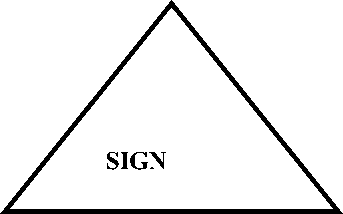A SEMIOTIC ANALYSIS OF ONWARD MOVIE POSTER
on
Udayana Journal of Social Sciences and Humanities, Vol. 7 No. 2, September 2023
1
A SEMIOTIC ANALYSIS OF ONWARD MOVIE POSTER
Ni Kadek Diah Budiari
Prodi Sastra Inggris, Fakultas Sastra dan Budaya, Universitas Udayana Bali, Indonesia
Abstract The aims of this research are to identify the semiotic signs which contain in “Oward” movie poster. to describe the meaning of semiotic signs that realized in “Onward” movie poster. The method of this research is qualitative method because the data of this research are in words not in numbers. The source of this research is “Imperfect” movie poster. The researcher uses the theory of Charles Sanders Peirce’s Triadic Semiosis to analyze the semiotic signs found in this poster. The researcher also uses the concept of advertising by Gillian Dyer to find the semiotic signs in the poster, as well as the concept of color meaning by Anna Wierzbicka to interpret the meaning of the colors contained in the poster. From the analysis, The poster told the information of the movie they watch that related to the date, location, genre of the movie. Based on the analysis of semiotic signs using Peirce’s triadic semiosis, there are verbal and visual can be intepreted by the audience namely the titles, characters, colors, and piece of events in the poster.
Keywords : Semiotic, Sign, Movie Poster.
-
i. Introduction1
Movie posters are created to give an idea of the film by way of illustration, while the movie trailer is made to display the pieces of film footage in certain parts, usually the important parts in the story, which at first glance appears to pose a public curiosity.
Advertising is any quite media want to inform people regarding one thing important, that is often meant to tell people to try to to one thing or buying for a certain product. one in every of the division of advertising media is “Movie Poster”. Movie poster continues to be associate unbelievably necessary a part of film’s promoting technique. The aim of a movie poster is to achieve interest in an exceedingly movie, an efficient thanks to distribute a movie in an exceedingly
wider vary of locations, and movie poster may offer us necessary data regarding the assembly context of the movie. Semiotics is defined as a science or method of analysis to examine the signs (the study of sign). Basically semiotics is the study of codes, any system that allows us to look at certain entities as something meaningful. Semiotics can be assessed through a variety of approaches, one of them is semiotic approach proposed by Charles Sanders Pierce, where he states that we can only think with the medium sign (Chandler 2002). Peirce looked at their relationship in the semiotic triadic, that is representamen, object and interpretation.
-
II. METHOD AND THEORY
-
A. Research Method
The data for this study were taken from a Poster advertisement “Onward”. It was Internet Movie Poster Awards on http://www.impawards.com which were published in May 2019. The method of this research is qualitative method because the data of this research are in words not in numbers. The technique of collecting data in this study, the data collected through some steps. The first step was by downloading the advertisement from the sites on the internet, second by observing the visual meaning from the advertisement such as colour, shape, etc. The data are analyzed with the relevant theory to get conclusion. Then, the writer observes the data to find the relevant concept to analyzed. The collecting data are analyzed descriptive and qualitative method. Identify the semiotic signs of the advertisements based on the theory by Peirce (1860), Peirce’s Triadic Semiosis to analyze the semiotic signs found in this poster. To finding the meaning that are conveyed by verbal and visual signs based on theory of semiotic by Dyer (1993). To analyze the meaning of colour term, by Anna Wierzbicka (1996).
-
B. Theory of Semiotic by Peirce
Peirce (1860), says that there are three sides of sign. The sides are representamen, object, and interpretant. In that book, Peirce says that a sign is something stands for something. Peirce gives a definition of representamen as the sign itself, the object is the thing which is referred, and the interpretant is the product from the connection between interpretant and object. Taking the example above, according to Peirce the word pen is the representamen, yet the object is the pen physically. For the interpretant is what thought which is appeared when someone hears pen, such as writings, ink, paper, letter, and so on.
-
1 Representamen (R)
According to Peirce (1940), every side of semiosis (representamen, object, interpretant) has its own classification. The Representamen can be divided into Qualisign which is formed by quality, such as the concept of color, sinsign which is formed by the real physical reality or the shape of a thing. Peirce says about Sinsign (sin is “being only once” as in single, simple, Latin semel) is actual thing or event. Then Legisign is the law or rule of how the thing should be such as the sound of whistle in the soccer match. Mostly the legisign is made by human being to organize the social life, and because of that almost all the convention is the legisign.
-
2 Object (O)
As for the relationship between the representamen and the object, object has three classifications too. They are icon which the sign has the resemblance with the fact of what it refers, or a sign which denotes and have the characters of the Object, whether the Object exists or not. The next classification is Symbol, the sign connected with the object
because of the agreement. Symbol is a general law or ideas which operate only in a particular situation, areas, or society. It should be noticed to differentiate symbol with legisign. Then, the index which the sign connected with the object because of the cause and effect connection. But, this connection is not so much. Index is anything which takes attention or startles us. Index has three characteristics: a. Index has no resemblance to their Object, b. It refers to individual or single unit, c. It directs the attention or startle to its Object.
-
3 Interpretant (I)
The interpretant has rheme, dicent, and argument. The rheme is the probability for interpretant such as a concept, the dicent is the fact of interpretant or the real description of a thing, then argument is logical reasoning of interpretant. In addition, in the Philosophical Writings of Peirce, the rheme is a qualitative possibility. It is the possibility interpretant which will be understood. The dicent (or dicisign) is a actual existence, and the argument is a sign of law such a sound of whistle in soccer competition.
Interpretant [I]

Representamen [R] Object [O]
Peirce believe that the three elements, and the respective classifications they imposed upon signs, could be combined to give a complete list of sign types. That is, since a sign has a sign-vehicle it can be classified as either a qualisign, a sinsign, or legisign. Additionally, since that sign has an object it can be classified as either an icon, an index, or a symbol. And finally, since that sign will also determine an interpretant it can be classified as either a rheme, a dicent, or a delome. Each sign is then classifiable as some combination of each of its three elements, that is, as either one of the three types of sign-vehicle, plus one of the three types of object, plus one of the three types of interpretant. Initially, this seems to yield twenty-seven possible classificatory combinations, but, because of certain of Peirce's phenomenological theories, there are restrictions on how we can combine the different elements that mean there are, in fact, only ten types of sign. (For more on the relation between
Peirce's phenomenological categories, and his sign typology, see (Lizska 1996) and (Savan 1988)).
This poster showed there are two characters in this film who sit in the iconic van car.
[I]
-
III. RESULT AND DISCUSSION
The data were analyzed by using Peirce’s Triadic model which consist of representamen, object, and interpretant. The representamen can be divided into qualisign, sinsign, and legisign. The object has three classification, they are icon, symbol, and index. The interpretant has rheme, dicent, and argument. Then, the writer also uses Dyer’s concept of verbal and visual to support the analysis of the poster. The color contained in the poster is analyze by using Wierzbicka’s concept of color terms.
Before proceeding to the analysis, the advertisement is shown in the form of image in order to get better understanding while reading the analysis. This poster was published in December 17th, 2019 by IMP AWARDS. Based on the analysis of the poster, the writer found three signs; the representamen, object, and interpretant.

The data is analyzed using Triadic semiosis by Peirce. The following data are explained in the diagram below:

The characters, the events and color contained in the poster [R]
Magic wand, white winged stallion. and
Iconic van car. [O]
-
1. A. Representamen
The qualisign found in this poster the color background which dominated by dark blue. There are additional color such as is blue, orange and red.
The sinsign found in poster is the expression showed by the characters. The expression all of the characters show smiling expression. But only the expression of Ian Lightfoot shows the shocked and serious.
The legisign of sign is based on Wierzbicka’s color terms that representing the meaning of color. Dark blue is the dominant color in this poster, symbolizes knowledge, power, integrity, and seriousness. Blue color represents tranquillity, health, healing, understanding, and softness. Orange color symbolizes fire and orange fruit color. Red represents vigor, willpower, rage, anger, leadership, courage, longing.
-
2. B. Object
The icon in this poster is a character belonging to the elf who symbolizes the story of the fantasy world. The symbol in this sign is a magic wand, iconic van car and white winged stallion or Pegasus. The magic wands and white winged stallion or Pegasus, represent the equipment that often used by elf. City represents an area in which a large number of people live fairly close together. Witch's old house represent an old house that often keeps magic objects. The forest represent a complex ecosystem consisting mainly of trees that buffer the earth and support a myriad of life forms. The index found in this poster is verbal text which used as information to audience such as the actors/actresses, movie titles, and the date of issues.
-
3. C. Interpretant
The interpretant found in this poster is dicent and argument. The argument are Onward, which is the tittle of the movie itself. And the casts name with the writer of the movie and the movie director’s name, release date and location the movie will be aired. The dicent found in poster 2 is based on the information found from website of Onward. There no rheme found in this poster.
In general, the Movie Poster of Onward have been put in front of movie theater or placed in the official website. The company put the poster in a suitable place with the intention to draw the attention of the audience. The poster told the information of the movie they watch that related to the date, location, genre of the movie. Based on the analysis of semiotic signs using Peirce’s triadic semiosis, there are verbal and visual can be intepreted by the audience namely the titles, characters, colors, and piece of events in the poster. The semiotic signs found in the movie poster of Onward are visual and verbal signs. Each posters contain picture of characters, they are Ian Lightfoot and Barley Lightfoot. There can be found the equipments that associated with elf such as magic wand and spell book. There are also mystical object like white winged stallion or Pegasus that represents Hercules' ride on a mission to kill monsters.
References
-
[1] Chandler, Daniel.2001. Semiotic for Beginners. WWW. Document
-
[2] Dyer, Gillian (1986). Advertising as communication. Methuen: Methuen Co. Ltd.
-
[3] Leech, G. (1981). Semantics : The Study of Meaning Second Edition. (Second Edition. ed.). Middlesex: Penguin Books Ltd.J.
-
[4] Wierzbicka, Anna. (1996). Semantics: Primes and Universals.New York: Oxford Peirce, Charles Sanders. 1940.Philosophical Writings of Peirce; Edited by Justus Buchler.New York: DOVER
PUBLICATIONS, INCUniversity Press.
-
[5] Devi, Beratha, Netra. 2017. Verbal and Non-verbal Signs of Zootopia Movie Poster. Journal. Udayana University. Denpasar.
-
[6] Persada, Satria Indra P. (2019). " Semiotic Analysis of Gundala Movie Poster". Journal, Atlantis Press.
-
[7] Juliantari, Ni Luh Putu. 2016. Semiotic Analysis of The Conjuring Movie Poster Advertisement. Udayana University. Denpasar.style)
Discussion and feedback